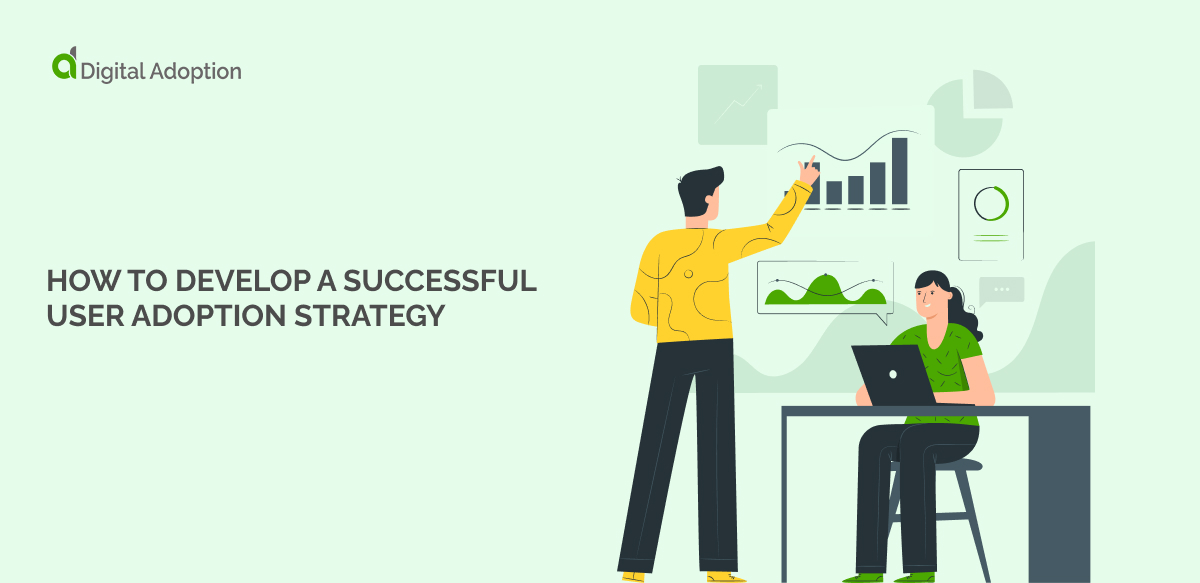With digital transformation (DX) underway for many global sectors, user adoption is becoming critical for achieving success – especially for product-led growth companies.
To navigate these transformations, organizations are prioritizing digital adoption and exerting efforts to encourage user adoption. Without effective user adoption strategies, new technologies and processes may be adopted as intended, which could result in implementation failures and lost opportunities for growth.
The importance of user adoption cannot be overstated, as without it, even the most cutting-edge technology will likely fail to achieve its intended benefits. Businesses that offer Software-as-a-Service (SaaS) should develop a comprehensive user adoption strategy from the outset, making it a fundamental aspect of sustaining customer longevity.
The key to user adoption is to ensure that the product or service meets the needs of its intended users at its core. This entails understanding the user’s pain points, preferences, and why they might resist change before making innovations.
According to Gartner, global spending on public cloud services by end-users is predicted to rise significantly in the coming years. It’s estimated to reach $591.8 billion in 2023, up from $490.3 billion in 2022, marking a 20.7% growth. The report claims that software-as-a-service (SaaS) is expected to grow 16.8% in 2023.
This article will delve into the critical topic of user adoption strategies. Many businesses may need to pay more attention to the importance of user adoption when launching their products or services. However, creating a well-thought-out user adoption strategy is crucial for outmaneuvering the competition and succeeding in today’s dynamic market.
In this piece, we’ll cover four essential areas:
- A User Adoption Strategy: Why It Matters
- Identifying Causes For Low User Adoption
- Developing A User Adoption Strategy: 6 Steps for Success
- Putting Strategic Goals Into Action
Whether you are an aspiring entrepreneur seeking ways to increase user adoption or a business executive looking to enhance engagement with an existing product or service, this article will provide valuable insights and guidance.
A User Adoption Strategy: Why It Matters
The provision of a user adoption strategy comes as the natural next step for businesses aiming to improve product adoption rates.
A user adoption strategy is essential because it helps create an effective and efficient customer acquisition and retention plan. Businesses can develop strategies specific to their target audience by understanding the user’s needs. This approach leads to an increase in adoption rates amongst existing customers and attracts new ones.
A well-crafted user adoption strategy can help a business identify its users’ needs, goals, and decision-making processes. Companies can use this information to create targeted marketing campaigns that are informative and effective. As a result, it can help reduce customer churn rates and increase product satisfaction.
A user adoption strategy matters because it provides a clear plan for businesses to target users who have yet to embrace the product fully or are unaware of its full features.
A user adoption strategy also allows companies to stay ahead of the competition by keeping on top of emerging trends in the market. It helps companies identify market gaps that they can exploit while avoiding the pitfalls of existing competitors.
Identifying Causes For Low User Adoption
Low user adoption is a frustrating challenge faced by many businesses. It is a complex problem that can have numerous causes. Here are some of the most common reasons for low user adoption:
A Decline in User Engagement: One of the main causes of low user adoption is a decline in user engagement. This may be due to a need for updates, new features, or regular bug fixes. When users feel that the app or website needs to be improved in some regard, motivation to continue using it is expected to falter.
Neglected Features: Another cause of low user adoption is neglected or overlooked features. It’s important to listen to user feedback and make required changes to the product. Certain features may not be user-friendly, and the users may find it hard to engage with them. This can lead to low user retention rates.
Onboarding Ineffectiveness: Many users who try a product out may not return. This could be due to poor onboarding. Users can quickly lose interest in the product if the user interface is not straightforward enough, instructions are unclear, or important features are left out of the training. Thus, nurturing a user’s first-time experience is crucial to cementing loyalty.
Insufficient Data for Management Insights: Low user adoption can also be due to inadequate data for management insights. It can be nearly impossible to fix the problem if you do not have the right data to analyze why users are leaving, causing the problem to become almost impossible to correct. Gather data from all touchpoints and analyze the users’ behaviors when interacting with the app or website.
Poor Customer Support: Poor customer support can be a major cause of low user adoption. Users want quick response times, personalization, and someone with authority to respond to their queries. If customer support is not meeting expectations, it can be a source of dissatisfaction and negative word-of-mouth, impacting user adoption.
Developing A User Adoption Strategy: 6 Steps for Success
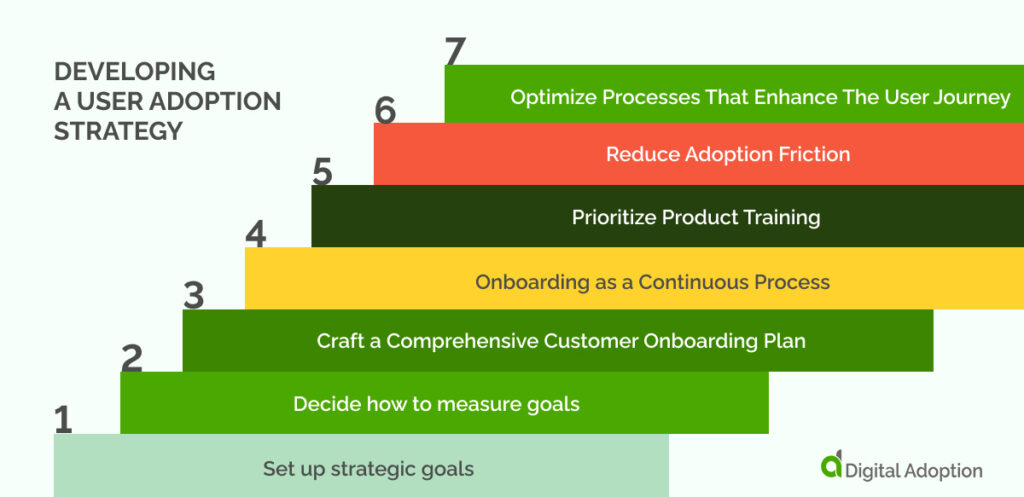
Getting users to adopt new products or technologies can take time and effort, regardless of how great the product or technology might be. The adoption rate for new products or technologies can range between 50 and 70%, according to some estimates. These challenges can significantly impact a product’s success and be a major hurdle for businesses looking to introduce new products.
Understanding the impact of your user adoption strategy requires a clear understanding of the target audience, their needs, and how they interact with the product. Companies must craft a strategy that resonates with their users, ensures higher adoption rates, and leads to sustainable product growth.
Below, we’ll explore six steps you can follow to create a user adoption strategy that will help businesses effectively deliver their product or service to their target market and encourage them to become active and loyal users.
By aligning your strategy with these steps, you can create a comprehensive and detailed plan to achieve successful user adoption.
1. Set up strategic goals
When developing a user adoption strategy, aligning your objectives with your business and user adoption end goals is essential. Starting with the overall business goals, such as increasing revenue or expanding your customer base, break them down into smaller, more specific, and achievable measurable objectives.
For instance, increasing conversions by 25% within the next quarter could be a specific objective if increasing revenue is the primary goal.
You can ensure a proactive, streamlined approach to sustained user adoption by aligning strategic goals with your business objectives. Leveraging SMART goals can provide businesses with a structured framework to ensure KPIs are well-defined, achievable, and aligned with broader objectives.
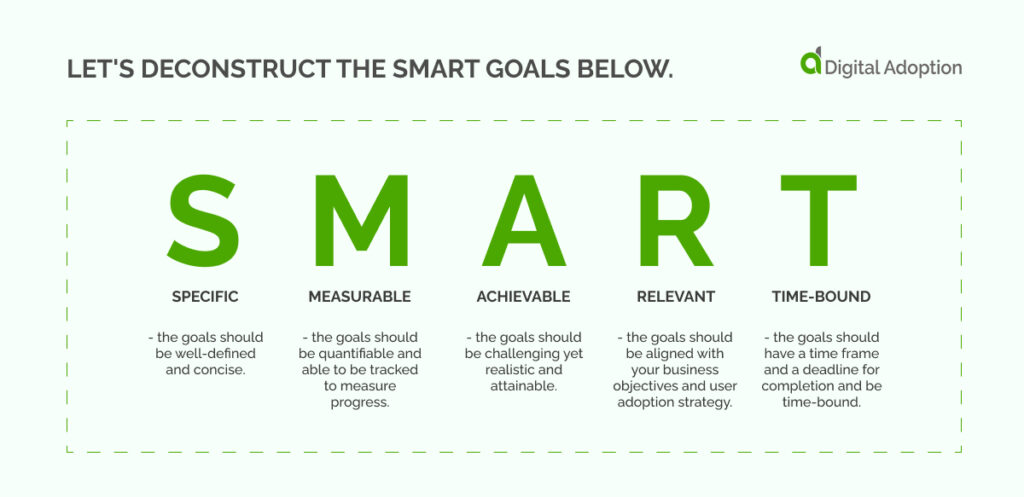
Let’s deconstruct the SMART goals below.
- Specific – the goals should be well-defined and concise.
- Measurable – the goals should be quantifiable and able to be tracked to measure progress.
- Achievable – the goals should be challenging yet realistic and attainable.
- Relevant – the goals should be aligned with your business objectives and user adoption strategy.
- Time-bound – the goals should have a time frame and a deadline for completion and be time-bound.
SMART goals can ensure the user adoption strategy is focused on achieving your business objectives, strengthening efforts in alignment with the overall business strategy. This approach helps to increase the effectiveness and efficiency of user adoption tactics, ultimately helping to achieve business goals faster and with greater success.
2. Decide how to measure goals
When crafting a user adoption strategy, it’s essential first to determine how you’ll measure your goals. This is where metrics and Key Performance Indicators (KPIs) come into play.
Understanding these two terms’ differences is crucial, as they work together to give you a full picture of how well your strategy is working. Metrics give you a broader understanding of your progress, whereas KPIs give you more specific insights into how well you’re meeting your goals.
Metrics & KPIs
Metrics are an important component of any user adoption strategy as they provide quantitative data on the performance of your product. These data points help to measure progress and can be useful in identifying areas to improve your strategy.
Key evaluation metrics include product adoption, customer satisfaction, attrition, conversion, and revenue.
For example, companies could use Google Analytics to track user behavior on their website or mobile app or send out a customer satisfaction survey to gauge their product’s usability and identify areas for improvement.
Once you understand your metrics, the next step is identifying the key performance indicators (KPIs) to track.
When using metrics and KPIs together, ensuring that your KPIs align with your overall objectives is crucial. For example, if your goal is to increase user engagement, you might look at metrics like the number of daily active users or the average session duration. These metrics then help determine the KPIs, such as increasing daily active users by 10% in the next month or increasing the average session duration by 20 seconds.
By combining metrics and KPIs, you can gain deeper and more meaningful insights into the performance of your user adoption strategy. You can track progress towards specific goals, measure the effectiveness of different tactics, and adjust your approach based on data-driven insights.
User Adoption Metrics and KPIs to Consider
It’s important to remember that the distinction between KPIs and metrics can depend on the context in which they are used. For instance, the same metric may serve as a KPI for one objective and simply be a metric for another.
Reflecting on this fact, here are a few key metrics and KPIs to consider when developing a successful user adoption strategy:
- Product Adoption Rate measures how many users have adopted your product or software and how quickly they did so.
- Time-to-Value: This metric measures how long a newly acquired customer takes to realize value from your product or service.
- User Attrition measures how many users you lose over a certain period, typically expressed as a percentage. It’s also often referred to as “churn rate.”
- Feature Adoption Rate measures how many users have adopted a specific feature of your product or software and how quickly they did so.
- Daily/Monthly Active Users: This metric counts how many users actively use your product or service daily or monthly.
- Time To First Action: This KPI measures the time it takes a new user to complete a key action, such as creating an account, making a purchase, or booking a service. This metric can help identify bottlenecks in the onboarding process and help improve usability.
- Net Promoter Score (NPS): This metric measures customer loyalty and satisfaction by asking how likely they are to recommend your product or service to others.
- Customer Retention: This KPI measures the number of customers who continue using your product or service over time. It indicates customer loyalty and the success of your user adoption strategy.
AARRR pirate metrics (Acquisition, Activation, Retention, Revenue, Referral)
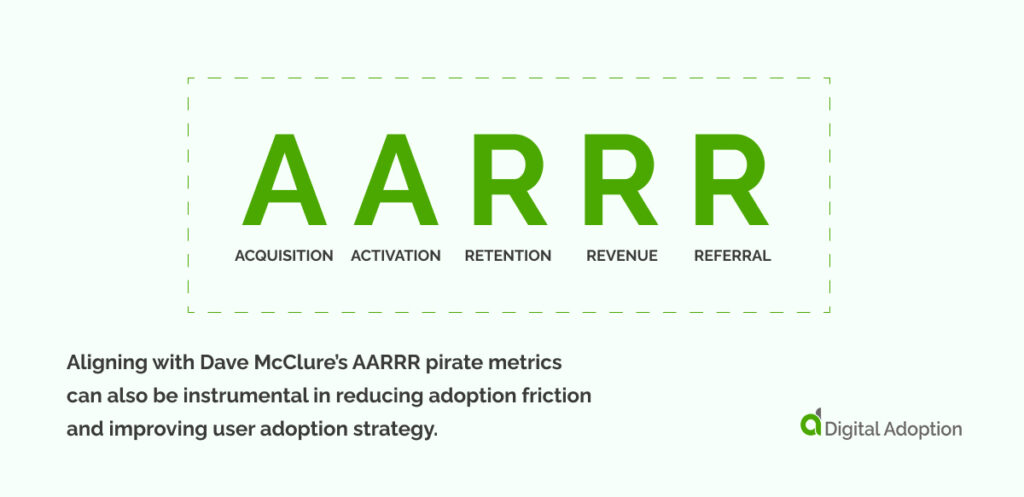
Aligning with Dave McClure’s AARRR pirate metrics can also be instrumental in reducing adoption friction and improving user adoption strategy.
By leveraging these metrics, you can identify areas of opportunity to optimize your user acquisition, activation, retention, revenue, and referral strategies. For example, by focusing on improving your activation metrics, you can ensure that users receive immediate value from your product and are more likely to continue using it. Similarly, by enhancing your retention metrics, you can increase the lifetime value of your users and improve your overall revenue metrics.
3. Craft a Comprehensive Customer Onboarding Plan
A comprehensive customer onboarding plan is essential for product-led growth businesses looking to build a successful user adoption strategy. This plan ensures that new users can quickly and easily understand the value of your product, its features, and its functions, making it easy for them to incorporate it into their daily routine.
A robust customer onboarding plan should be designed to work hand-in-hand with a user’s journey, providing targeted and contextualized support at each process stage. By guiding users through the product and its features, you increase the likelihood of them becoming regular customers or even advocates for your brand.
According to insights via Precursive, 74% of enterprise firms have a dedicated customer onboarding team, while 82% rate their onboarding approach as a key value driver. This highlights the importance of prioritizing investment in a dedicated team to successfully guide customers through onboarding, which can contribute to a positive customer experience while driving business growth.
The first step in developing an effective onboarding plan is identifying the core user personas most likely to benefit from your product. This allows you to tailor your onboarding experience to their needs, making them more likely to engage with your product and ultimately become loyal customers.
Businesses should also create interactive and engaging onboarding experiences that take users through key product features and functions. Incorporating videos, interactive tutorials, and user guides can be effective ways to ensure users are engaging with and understanding the product.
The final step is gathering user feedback throughout the onboarding process to optimize and improve the experience continually. This feedback will help you identify areas for improvement and adjust your onboarding process accordingly.
Crafting a comprehensive customer onboarding plan is key to the success of any product-led growth business. By providing users the support they need to engage with your product and understand its value, you increase their likelihood of becoming loyal customers and advocates for your brand.
4. Onboarding as a Continuous Process
Now that we’ve covered customer onboarding let’s discuss onboarding as a continuous process.
Continuous onboarding improves user adoption for any product or service, especially in product-led growth businesses like SaaS companies. Treating it as a one-time event is a mistake that many businesses make.
As users move through the different phases of a product’s life cycle, they need to feel that they are continually discovering and learning new things about a product. Initially, users must experience value early on in the product lifecycle. This early value assists in acquiring new users and leads to growth in revenue. However, retaining users through continuous onboarding is just as important.
A continuous onboarding program helps educate users on a product’s features and benefits while increasing their knowledge of how they can use them to optimize their experience. Consistent engagement through targeted and educational content is critical in keeping users invested in a product. Furthermore, feedback mechanisms allow businesses to recognize areas where the product falls short and adjust the onboarding accordingly.
Creating a community of users who feel that they are continually learning and growing together is key to a successful continuous onboarding program. This community cultivates a strong sense of engagement and advocacy that can lead to more organic growth through word of mouth.
Implementing a comprehensive continuous onboarding program helps deliver value throughout the customer journey, tighten the SaaS sales funnel, and deliver a highly personalized experience that improves the customer’s overall perception of the service or product.
5. Prioritize Product Training
Developing a successful user adoption strategy also requires prioritizing enhanced product training. While a good product is essential, users must understand how to use it and get the most out of it.
A comprehensive training program ensures that users have the knowledge and skills they need to use the product effectively and feel confident in their ability.
Training programs should be designed to meet the needs of different users with various learning preferences. By providing them with varying training options, such as live webinars, video tutorials, product documentation, or personalized training sessions, users are likelier to find training methods that work best for them, leading to deeper engagement and increased satisfaction.
An effective user adoption strategy also involves empowering users to be self-sufficient by making training resources easily accessible. Training resources should be available when users need them, whether accessing a searchable knowledge base or an on-demand video tutorial. This approach can lead to better-informed users, higher product usage rates, and increased overall adoption.
Prioritizing enhanced product training as part of a user adoption strategy demonstrates a commitment to user success, and the time and resources invested in training will pay off. Product adoption will increase with well-trained and satisfied users, increasing retention, loyalty, and customer lifetime value.
6. Reduce Adoption Friction
As a product-led growth business, your ultimate goal is to acquire, activate, retain, and monetize users. But sometimes, even the most well-designed products need help attracting and retaining users. This is where reducing adoption friction comes into play.
Adoption friction refers to the obstacles or hurdles that prevent potential users from adopting your product. These can include anything from a difficult sign-up process to not understanding how to use the product. When users face adoption friction, they are likelier to abandon your product and never return.
An effective way to reduce adoption friction is to create a user-centric onboarding experience. This onboarding experience should guide users through the product intuitively and easily. It should highlight key features and benefits and provide clear instructions on using the product.
Another way to reduce adoption friction is by addressing user concerns and providing timely support. When users face challenges or have questions, they need to be able to access support resources easily. By providing a responsive support system, you can demonstrate your commitment to your users and improve overall user satisfaction.
Utilizing AARRR pirate metrics and reducing adoption friction can be particularly helpful in creating a healthy user growth and success cycle.
7. Optimize Processes That Enhance The User Journey
To truly develop a winning user adoption strategy, companies must take the final and most important step of assessing, evaluating, and adjusting the processes contributing to a sound user journey.
This final step requires a comprehensive approach to identify and analyze all touchpoints throughout the user journey. This includes the obvious steps, such as website visits or product demos, and the less obvious touchpoints, such as email communication, customer feedback, and social media interactions.
Through this process, companies can identify areas where the user journey can be optimized for maximum impact. By evaluating the processes contributing to the user journey, companies can uncover hidden growth opportunities, identify areas of improvement, and ultimately adjust the entire user journey to improve user adoption rates.
Optimizing processes that enhance the user journey is the first step toward building a successful user adoption strategy. The final step of evaluating and adjusting the entire user journey from end to end is critical to achieving long-term user adoption success, fostering customer loyalty, and driving growth for product-led businesses.
Putting Strategic Goals Into Action
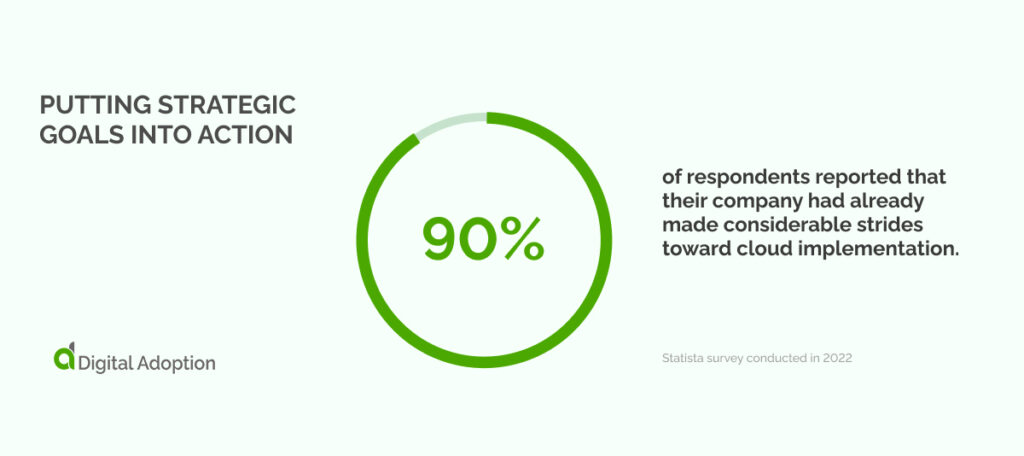
According to a Statista survey conducted in 2022, 90% of respondents reported that their company had already made considerable strides toward cloud implementation.
This finding highlights the growing complexity surrounding the future of sustained user adoption.
Among various cloud computing models, Software as a Service (SaaS) emerges as the largest segment of the global cloud market, generating revenues upwards of 100 billion U.S. dollars as of 2019. Unsurprisingly, it is now the most widely adopted cloud technology worldwide and is currently deployed by many organizations.
Increasing cloud adoption worldwide means that companies must be mindful of users’ challenges when using their software. To promote user adoption, companies must understand the user experience and offer comprehensive training to ensure users navigate the learning curve and reach that “Aha” moment.
Launching a successful user adoption strategy can be demanding, so it is important to stay agile and adaptable to ensure that you are meeting the intended outcomes.
As businesses implement the steps outlined in this article, remember that continuous strategy evaluation will enable you to refine and pivot your approach accordingly. Taking this iterative mindset will ensure that the adoption strategy is effective and well-received by users.
Always remember to prioritize empathizing with users and making constant improvements in your implementation to achieve the desired results.

